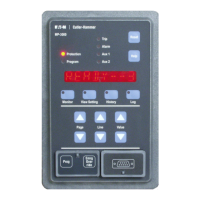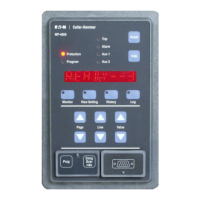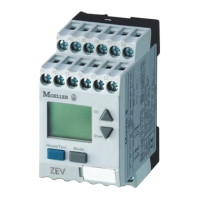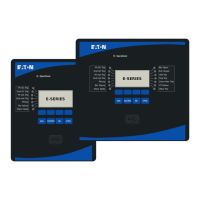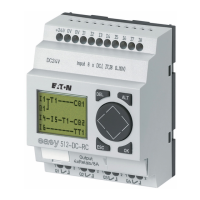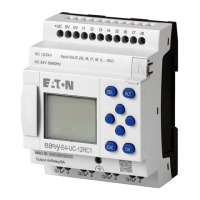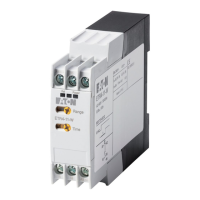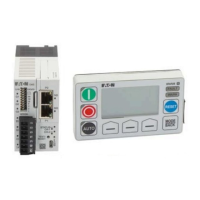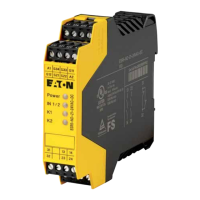Page 9-2
Effective 10/02For more information visit: www.cutler-hammer.eaton.comIL17562BH04
motor capacity. When the integrated effective heating current squared
exceeds this limit curve at any time in the start or run cycle, the MP-
3000 trips the motor.
The MP-3000 automatically calculates the correct motor protection
curve from nameplate or manufacturer values of full-load amperes
(FLA, P1L1); locked-rotor current (LRC, P1L2); maximum allowable stall
or locked-rotor time (LRT, P1L3); and service factor as used to set
ultimate trip current (UTC, P1L4). The following subsections describe
how such a typical curve is obtained.
Note that, for now, we assume that the three phase currents are
balanced and have proper 120 degree phase relationship (i.e., only
positive sequence current). If negative sequence current reflecting
unbalance is present, the MP-3000 gives much heavier weighting to the
heating effect of these currents, and tripping will occur sooner than
expected from balanced-current curves.
9.1.3.1 Instantaneous Overcurrent Function
This function is intended mainly to trip for high-current faults. The
example instantaneous overcurrent setting used in Figure 9.2 is
12 times (1200 percent) of FLA. In general, the instantaneous
overcurrent setting (IOC, P3L4) should be at least 1.5 times LRC - well
above the locked-rotor current normally seen at the moment of a start.
CAUTION
MOST CONTACTORS ARE NOT RATED TO INTERRUPT HIGH-
CURRENT FAULTS. FREQUENTLY, THE MOTOR CONTROL
CENTER ALSO CONTAINS FUSES, WHICH CAN INTERRUPT
THESE FAULT CURRENTS.
THE MP-3000 TRIP COMMAND IS INTENDED TO OPEN ALL
THREE PHASES VIA THE CONTACTOR AND BLOCK FURTHER
STARTING, BUT THE FUSES MUST INTERRUPT THE LARGE
CURRENT IN FAULTED PHASE(S). IF THE CONTACTOR INTER-
RUPTING RATING IS EXCEEDED WHEN THE MP-3000 TRIPS
WITHOUT THIS FUSE BACKUP, THE CONTACTOR OR MOTOR
CONTROL CENTER COULD BE DESTROYED IN A HAZARDOUS
OR EXPLOSIVE CASCADING FAULT SITUATION.
ANOTHER ACCEPTABLE APPLICATION IS TO CONNECT THE
MP-3000 TO DIRECTLY TRIP A CIRCUIT BREAKER WHICH HAS
AN INTERRUPTING RATING EXCEEDING THE HIGHEST AVAIL-
ABLE BOLTED-FAULT CURRENT.
IOC should trip fast; no run or pickup delay is provided. A start delay
(IOCSD, P3L5) is set at a minimum of two cycles, or more if needed to
block IOC tripping on magnetizing inrush when the motor is first
energized. Note that the entered IOCSD value is the total IOC trip time,
including pickup time of the basic IOC measurement algorithm, and
cannot be set below two cycles.
9.1.3.2 Locked-Rotor Function
The family of curves shown in Figure 9.2 is based upon a locked-rotor
current setting (LRC, P1L2) of 6.1 times (610 percent) of FLA (P1L1) and
a family of locked-rotor or stall time settings (LRT, P1L3).
All curves shown in Figure 9.2 are based on a maximum allowable stall
time from a cold start. The nameplate LRT used for setting is normally
a cold-start value. Since the thermal algorithm actually retains recent
operating history as reflected in the thermal bucket level, it is not
necessary to program the MP-3000 for hot starts—hot start protection
is automatic. Note that the effective limit curve for a hot start is
actually more restrictive, i.e. more limiting in time and current, than the
cold-start curve of Figure 9.2.
The Emergency Overrride function, if invoked, lowers the thermal
bucket to cold level regardless of recent history and restores the cold-
start curve. Use this only for a real process emergency—it defeats the
thermal-modeling protection, and the motor is at risk.
9.1.3.3 Ultimate Trip
The setting for the ultimate trip function is the value of current above
which the motor can be damaged over time. Figure 9.2 shows a
setting of 100 percent, reflecting a nameplate service factor of 1.0 and
an ambient temperature that doesn’t rise above 40 degrees C. If the
motor has a service factor different from 1.0, the ultimate trip current
level is adjusted accordingly. Other common service factors are 0.85
(UTC=85%) and 1.15 (UTC=115%).
As explained above and in Section 5, UTC sets the upper continuous
limit if stator RTD temperature measurements are not available. The
time to trip after the UTC threshold is crossed depends on recent
operating history, and on the thermal-bucket size defined by settings.
With stator RTDs reporting acceptable temperature, the algorithm can
allow sustained operation above UTC. Make sure the winding direct
thermal trip temperature setting (WD T) is not turned OFF, or the
algorithm reverts to strict use of UTC.
9.1.3.4 Underload Functions
When the motor is running, a current reduction might indicate a
malfunction in the load. Underload protection recognizes mechanical
problems, such as a blocked flow or loss of back pressure in a pump,
or a broken drive belt or drive shaft.
Refer to the underload protection limit—the left vertical line - in the
Underload–Jam Protection Curve example of Figure 9.3. Here, the
underload trip is set at 60% of FLA. The MP-3000 has settings for
underload alarm (ULA, P4L5), and underload trip (ULT, P3L9). Each can
be disabled by setting to OFF. These would be represented by two
such vertical lines, both below the normal load current. Be sure to set
the alarm level above the trip level. Both trips and alarms are held off
by start delay ULSD, P3L10. Each has its own run or pickup delay -
ULTR, P3L11 and ULAR, P4L4. Use the start delay to block tripping
until the load stabilizes after a start; and use run delays to avoid
nuisance alarms or trips for load transients.
9.1.3.5 Jam Functions
When the motor is running, a current increase way above normal load
might indicate a malfunction in the load. Jam protection recognizes
mechanical problems, such as broken drive gears.
Refer to the jam protection limit—the right vertical line - in the Under-
load–Jam protection curve example of Figure 9.3. Here, the jam trip is
set at 150% of FLA. The MP-3000 has settings for jam alarm (JMA,
P4L3), and jam trip (JMT, P3L6). Each can be disabled by setting to
OFF. These would be represented by two such vertical lines, both well
above the normal load current. Be sure to set the alarm level below the
trip level. Both trips and alarms are held off by start delay JMSD,
P3L7. Each has its own run delay - JMTR, P3L8 and JMAR, P4L4. Use
the start delay to block tripping until the motor current drops to
continuous load level; and use run delays to avoid nuisance alarms or
trips for load transients.
9.1.4 Complete Motor Protection Curves
To illustrate the protection features of the MP-3000, two sample
curves are shown. Using specific motor data, typical motor protection
curves for the MP-3000 without RTDs are shown in Figure 9.4. The
use of RTDs is assumed in Figure 9.5. The following data were used:
• Balanced currents during start and run cycles.
• Instantaneous overcurrent limit IOC of 12 times FLA

